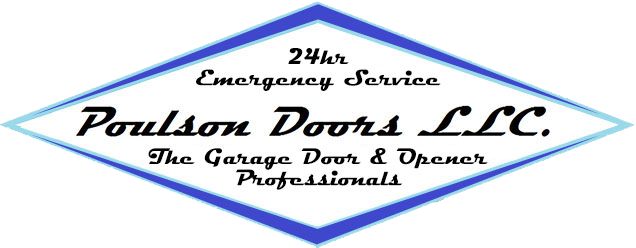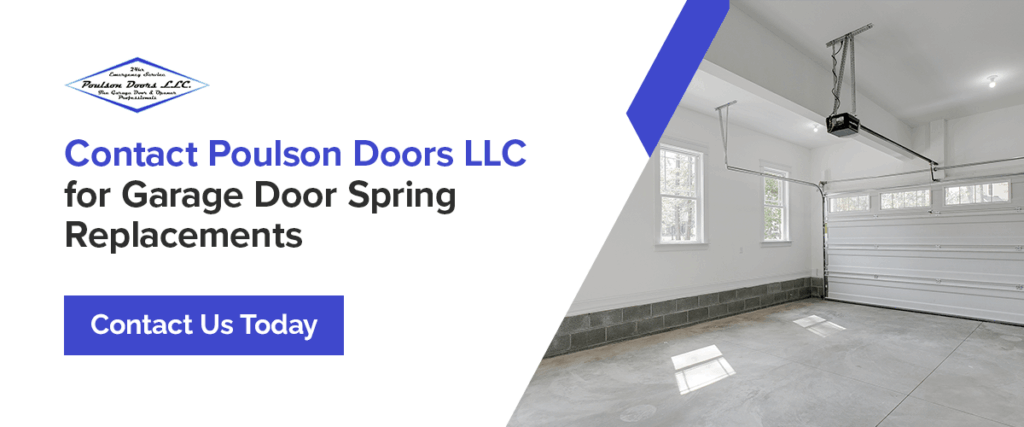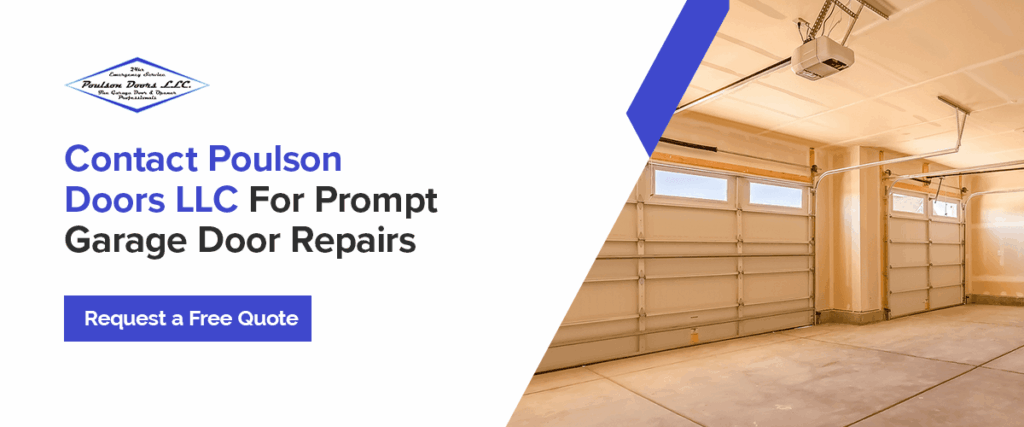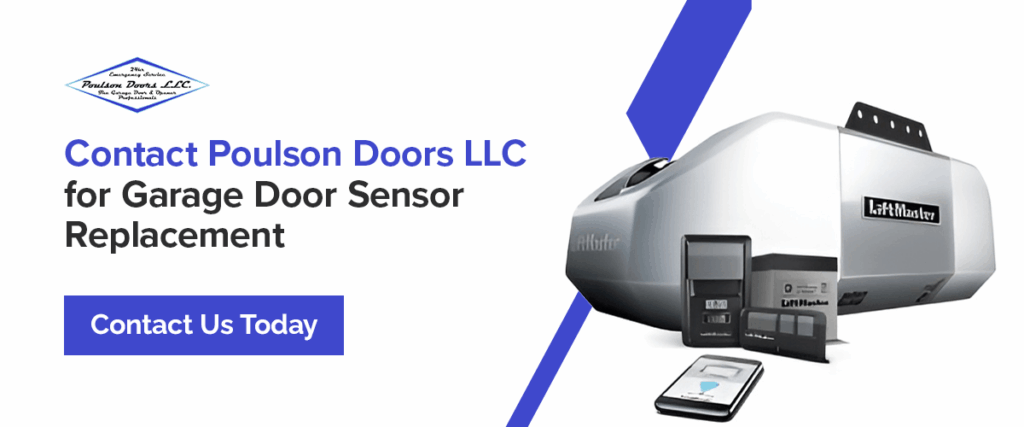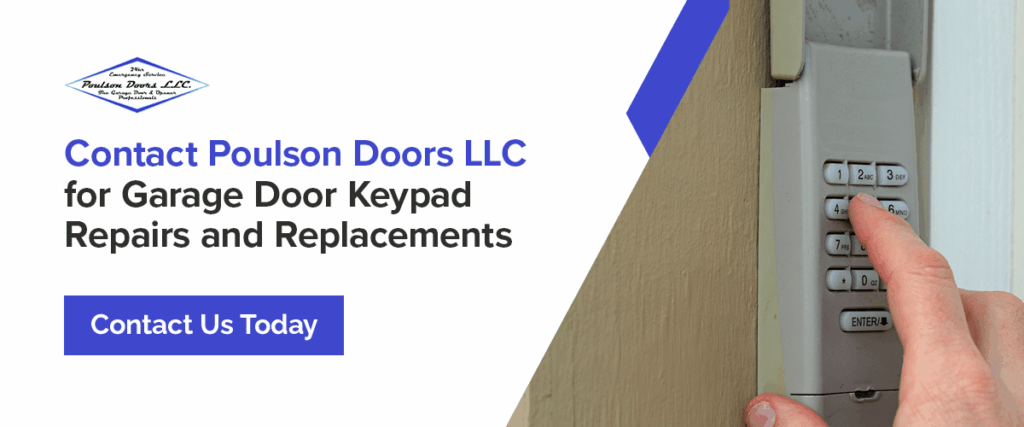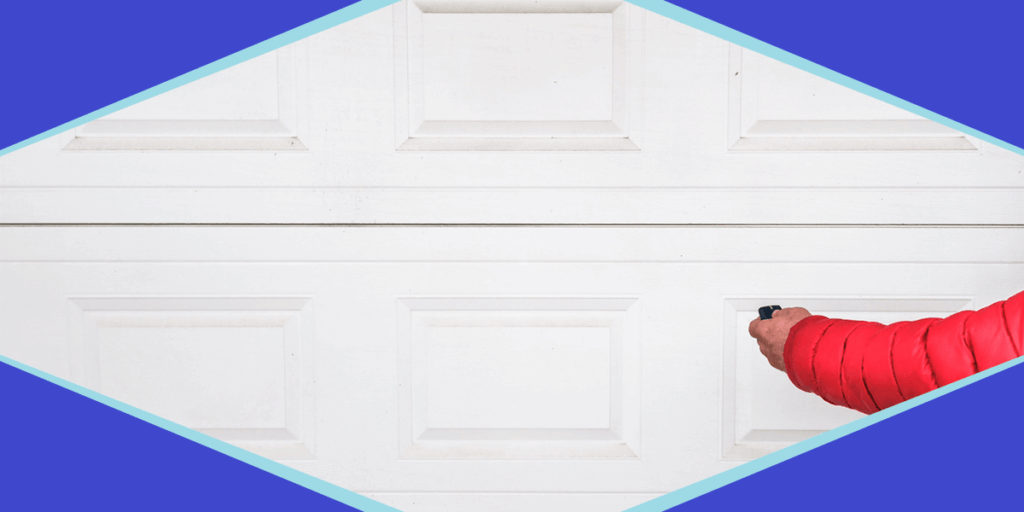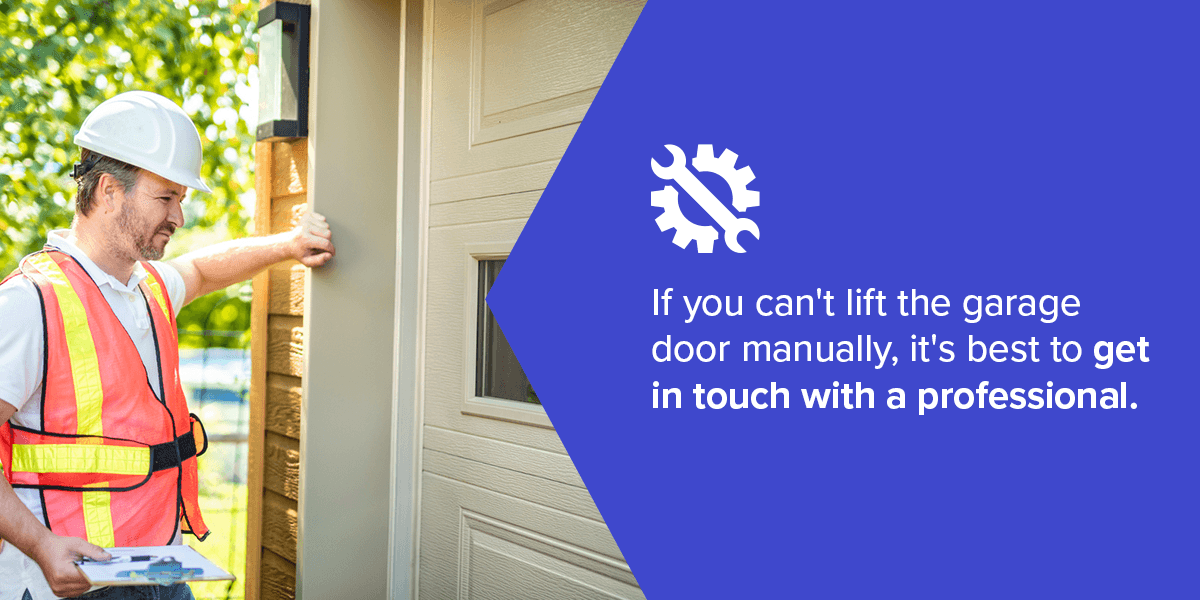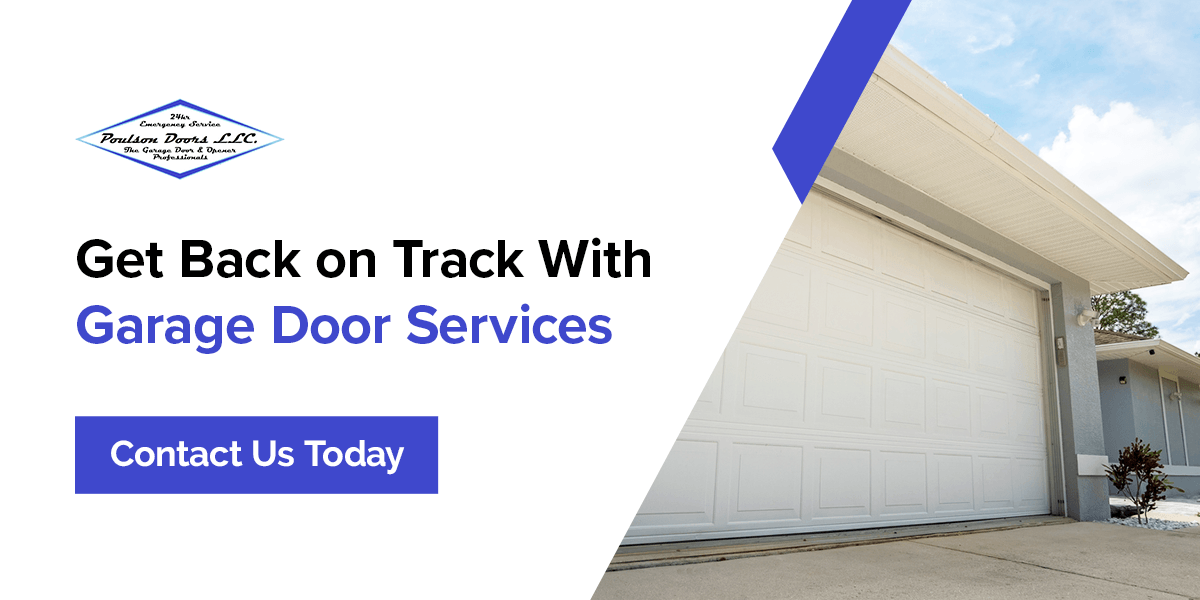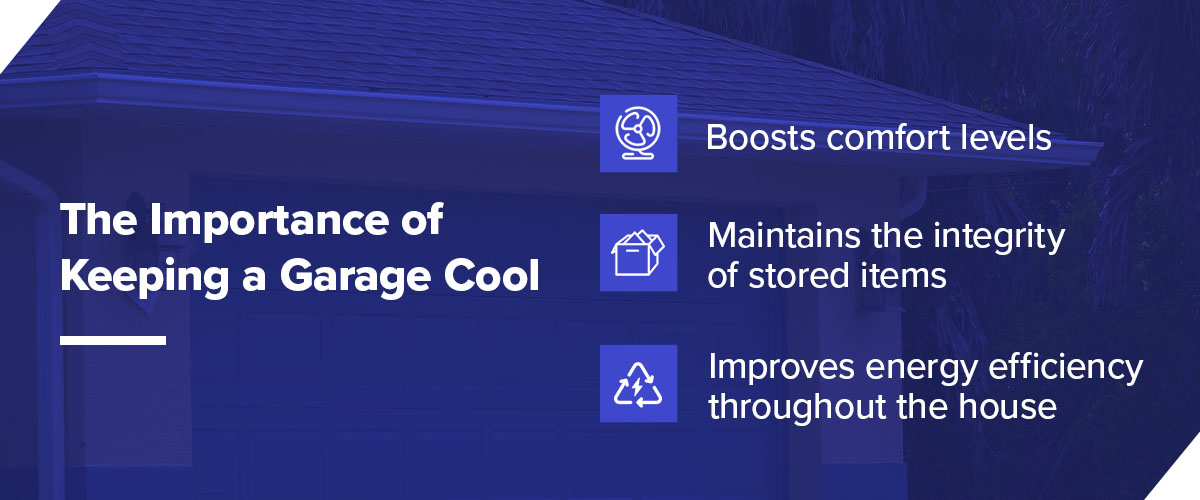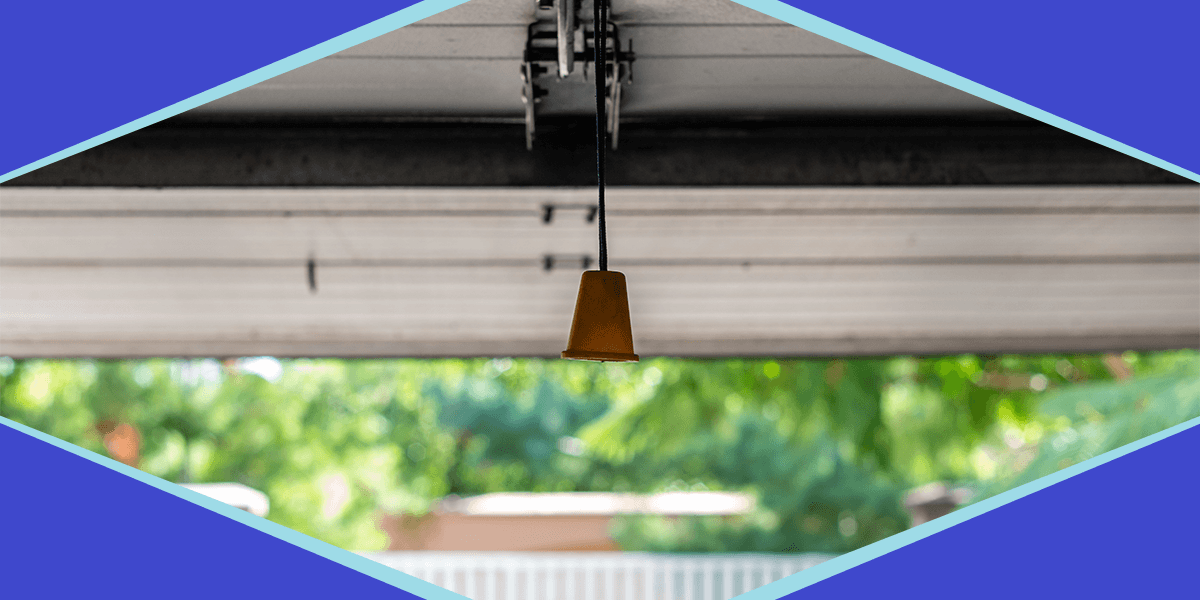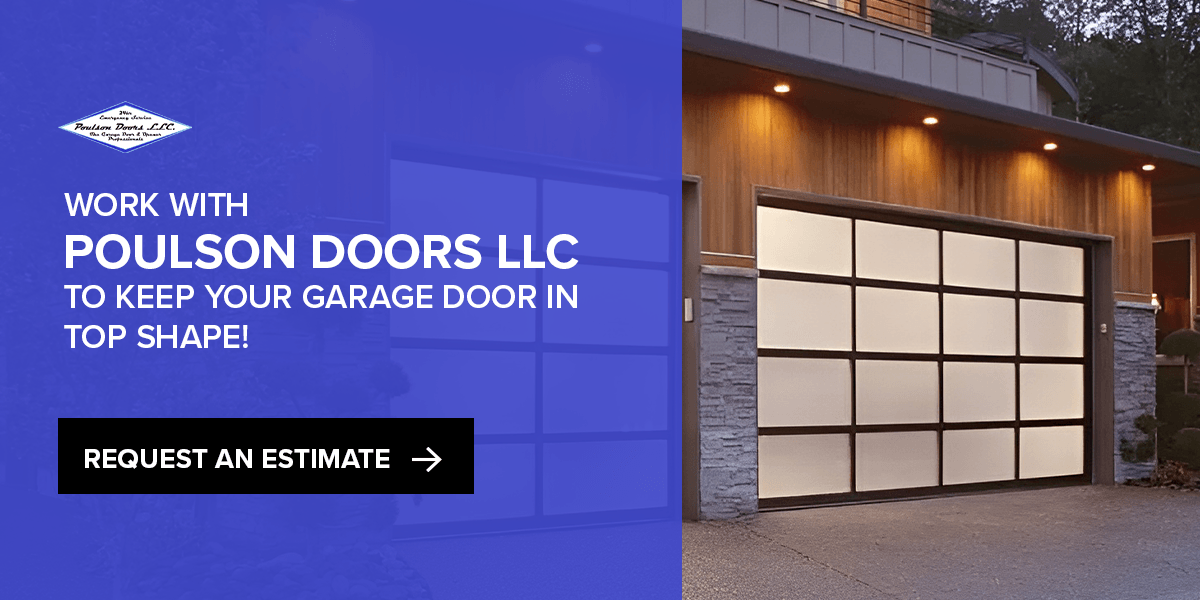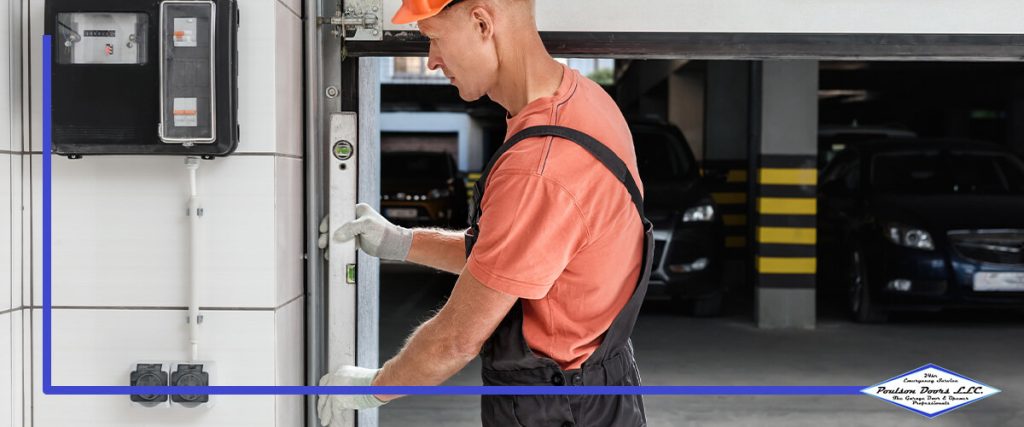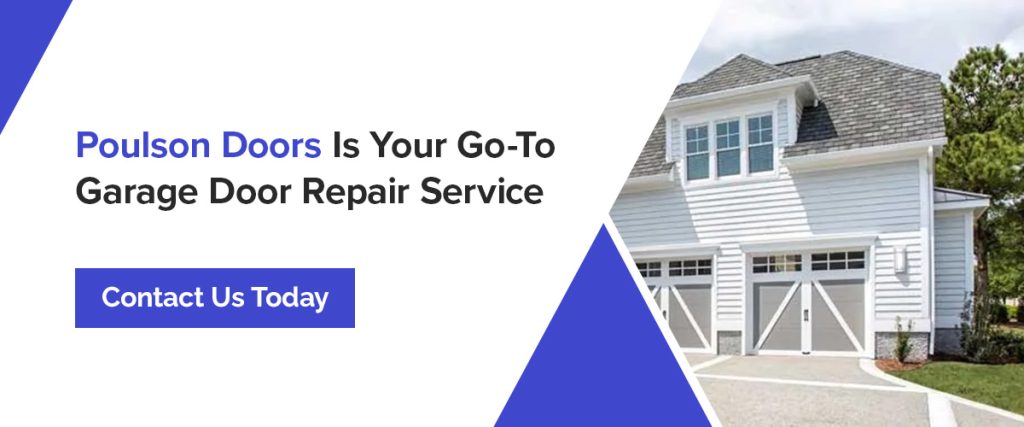How to Maintain Garage Door Springs
Garage door springs enable your door to open and close smoothly multiple times daily. All that work takes its toll, so maintenance is necessary. Keeping garage door springs in good condition through regular maintenance can extend their lifespan and ensure your garage door is reliable, so you can get on with life and avoid costly repairs later.
Why You Need to Maintain Your Garage Door Springs
Your garage door’s springs are responsible for balancing the weight and ensuring proper door tension so it can operate smoothly. Maintaining your garage door springs helps avoid damage from wear, prevents premature replacement, and limits pressure on your opener.
Garage door spring maintenance also helps prevent damage and injury. Since garage door springs are under a lot of pressure, a sudden break or failure can cause the door to fall or become stuck.
Common causes of garage door springs failing include:
- Wear and tear: Springs weaken over time with repeated use.
- Lack of lubrication: Dry springs experience more friction, leading to faster wear.
- Rust and corrosion: Exposure to moisture causes rust, which weakens the metal and causes friction.
- Improper spring size or type: Using the wrong spring type for your door can cause premature failure.
- Sudden temperature changes: Extreme hot or cold weather can affect the spring’s flexibility, causing the metal to crack or break.
How to Maintain Your Garage Door Springs
Here’s how you can keep your garage door springs in good condition with proper maintenance:
- Regular visual inspections: Check the springs for gaps, rust or signs of wear. Also, check for loose, frayed cables connected to the springs.
- Spring tension tests: With the opener disconnected, manually lift the door halfway. If it moves on its own, the springs might need adjustment. If it stays in place, the tension is correct.
- Spring lubrication: Use a high-quality garage door lubricant every three to six months to keep the springs moving smoothly.
- Spring cleaning: Wipe away dust, dirt and debris and ensure the area around the springs is clear of obstructions that could disrupt movement.
Important to note: Never come in contact with the spring. It can snap or release suddenly, causing serious injury.
For door maintenance or cleaning, always check the owner’s manual and read all warning labels. Never use brake cleaner, as it is harmful and can ruin the paint.
How to Properly Lubricate Garage Door Springs
Follow these steps to properly lubricate the springs:
- Prep the door: Inspect the hinges and rollers. If they are covered in grime, clean them with a cloth and a silicone-based lubricant. Allow it to dry.
- Identify the type of spring: Torsion springs have a single spring above the door. Extension springs are on either side of the door.
- Apply lubrication to springs: If lubricating a torsion spring, spray the garage spring lubricant along its length. For extension springs, apply lubricant to the pulleys.
What to Spray on Garage Door Springs
Before lubricating, you must decide on the best lubricant for garage door springs. Avoid WD-40 because it can attract dust and dirt, causing more harm than good. Instead, use a silicone or lithium grease-based lubricant.
Lubrication Tips
- Disconnect the opener first: Make sure to disconnect your opener before applying the lubricant to the springs to avoid injury.
- Repeatedly open and close: Work the lubricant into the moving parts by operating the door several times. If you hear grinding or squeaking, you might need to apply more lubricant.
- Avoid over-lubricating: Excess lubrication attracts and traps dirt, which can damage the springs. Wipe excess lubrication with a clean cloth.
How to Identify Worn or Damaged Springs
Springs counterbalance the door’s weight — the door won’t stay in place without proper tension. Identifying worn and damaged springs quickly is essential to maintaining safety and the condition of your garage door. Here are some of the most common signs to look out for:
- Frequent need for adjustments: If you need to adjust your door’s position or tension frequently, the springs might be wearing out and losing their ability to hold the door’s weight.
- Difficulty opening or closing: If your garage door struggles or takes a long time to open or close smoothly, the springs could be worn or lose tension.
- Door falls or stops midway: If your door suddenly falls or stops halfway, it could be a spring failure.
- Crooked door movement: If one side of your garage door moves faster than the other, one of the springs might be damaged or broken, making the door unbalanced.
- Visible damage: Inspect the springs for visible damage, such as gaps in the spring coils, rust or corrosion. Any noticeable wear can weaken your spring’s ability to support the door.
- Unusual noises: A sudden loud bang or snapping sound could indicate a spring breaking. If you hear grinding or squeaking sounds, it indicates your springs need lubrication.
When to Call the Professionals
Listen for unusual noises like creaking, squeaking, or snapping when the door’s opening or closing. These could indicate the need for professional attention. Springs usually last 10,000 cycles — depending on how often you use your door, this could be 10 years or less. Even with regular garage door spring maintenance, it’s a good idea to have a professional inspect the springs annually. Professionals can detect hidden signs of wear, make necessary adjustments, and replace springs before they fail.
If you have a broken spring, don’t attempt to replace it yourself. Springs are tightly wound and can cause serious injuries. It’s best to call in the garage door and opener professionals at Poulson Doors LLC to prevent serious door damage and minimize pressure on your opener. Calling our experienced technicians to attend to your springs can also reduce the risk of high garage door spring repair costs.
Contact Poulson Doors LLC for Garage Door Spring Replacements
If your garage door springs are worn or damaged, don’t wait for them to worsen. At Poulson Doors LLC, we specialize in safe and professional spring replacements, ensuring your garage door operates quietly and reliably. Our team has the expertise and equipment to handle spring replacements fast and efficiently, preventing potential damage to your door and safety hazards. Contact us today to request service or get a free quote to keep your garage door running like new.
Why Is My Garage Door Not Opening?
Most property owners take their garage doors for granted — until their trusty garage door won’t open. Getting stuck in or outside your home or business can result in missed appointments or security issues. Garage door systems are intricate and pose a significant safety risk if mishandled, but there are some basic ways to troubleshoot a faulty garage door before calling professional help.
Why is your garage door not opening? Let’s find out!
Common Reasons Your Garage Door Won’t Open
The reliable operation of garage doors requires multiple components and systems to work together in unison to create smooth open-and-close functionality. Some common reasons why the garage door won’t open when you press the remote include the following:
- Power supply issues
- Broken springs or cables
- Significant structural damage to the doors
- Manual lock engagement
- Issues with the remote
- Faulty garage door opener
- Sensor misalignment or obstruction
- Track misalignment or damage
There are many other possible causes of garage door malfunction, but identifying the most likely issues can help you determine the cause and restore functionality faster.
Garage Door Troubleshooting 101
Garage doors must always be regarded with extreme caution. These complex, heavy fittings operate under high tension, making DIY fixes beyond the basics hazardous. However, unless the cause of the uncooperative door is apparent, you can try the following:
- Check the power source: Ensure the circuit breaker hasn’t tripped and the opener is plugged in.
- Replace remote batteries: Swap exhausted batteries with fresh ones.
- Reset the garage door opener: Consult the user manual to resync the device.
- Clear sensor obstructions: Clean the sensors and move any obstacles that may be blocking the door’s path or sensors.
- Check the door’s manual lock: Make sure that the garage door’s manual lock isn’t engaged.
If you have tried all these fixes and your garage door is still not opening, it is time to call your local garage door professionals.
Safety First: When to Call a Professional
Ensuring safety and restoring your garage doors to full functionality often requires the services of trained professionals. Many common causes for unexpected malfunctions are mechanical issues resulting from damage or wear and tear. These problems cannot be repaired without specific expertise and tools and must only be undertaken by garage door specialists.
- Broken springs: Restore functionality by having a replacement spring fitted.
- Frayed or snapped cables: Replace the door’s cables at the first sign of staggering motion or uneven movement.
- Bent tracks: Keep your garage door gliding smoothly on carefully aligned tracks.
- Opener issues: Ensure that your garage door opener is in good working order and is powerful enough to lift your garage door reliably.
- Electrical malfunctions: Upgrade your electrical components promptly if there are any signs of a short circuit or visible smoke around the system.
- Structural damage: Replace the entire door or a few panels if the door has sustained an impact or environmental damage.
- Unusual noises: Let professionals identify the exact issue to restore functionality.
Prevent Repairs With Regular Garage Door Maintenance
Routine maintenance is the most effective way to prevent garage door malfunctions. Professional garage door maintenance services can significantly increase the lifespan of your investment and ensure peace of mind each time you press the remote.
Comprehensive garage door maintenance should include these services:
- System inspection and assessment
- Lubrication and adjustment
- Replacement of worn parts
- Track alignment
- Safety sensor testing
Timely maintenance ensures your garage doors remain safe and last as long as possible. If your older system continues to malfunction frequently, it may be time to upgrade to modern garage doors. A new garage door installation is also a great way to increase the value and enjoyment of your property.
Contact Poulson Doors LLC For Prompt Garage Door Repairs
Minimize risk and get your garage doors back in reliable working order with services from local professionals you can trust. Poulson Doors LLC offers same-day and 24/7 emergency garage door repairs throughout the Wasatch Front, so you never have to feel trapped by a garage door that’s not opening. We will quickly identify the cause and make repairs so you can focus on commitments without the stress and risks associated with garage door DIY.
Request a free estimate to have your commercial or residential garage doors repaired or replaced, or contact us today for a maintenance service to keep your garage doors opening reliably.
How to Align Garage Door Sensors
Garage door sensors keep your garage door safe and functioning properly. Sensors are small devices near the bottom of the door tracks. Their purpose is to prevent accidents and damage, using an infrared beam to detect obstacles and prevent the door from closing on anything in its path.
When sensors misalign, your garage door might not close or reverse unexpectedly. Keeping your sensors aligned ensures safe, reliable operation and helps you avoid costly repairs.
What Causes Alignment Issues?
Garage door sensors can become misaligned for several reasons, leading to malfunction or inconsistent operation, including:
- Accidental impact: Sensors are typically mounted around 4 inches above the ground, so they can easily be bumped by bikes, tools and foot traffic.
- Debris buildup: Dirt can accumulate on the sensor lenses, interfering with the infrared beam. Dirt buildup can block the sensor’s signal.
- Light interference: Bright sunlight or strong artificial lighting near the sensors can disrupt the infrared beam and cause false readings.
- Loose mounting: Vibration from regular door operation can loosen the mounting brackets that hold the sensors in place.
- Warped tracks: If the garage door tracks warp due to temperature fluctuations, impact or poor installation, it can affect the positioning of sensors.
- Wiring issues: Loose, frayed or disconnected wiring can interrupt the power supply to the sensors, causing them to malfunction.
- Corrosion: The metal brackets and screws that hold sensors in place can become weak and shift due to corrosion, causing the sensors to misalign and fail.
How to Know if Your Garage Door Sensor Is Not Working
If your garage door sensors are not working properly or have become misaligned, you may notice several warning signs, which mean your sensors need realignment, cleaning or repair. The most common signs include:
- Buildup on sensor lenses: Dirt, fog or dust buildup can interfere with the sensor’s infrared beam. Cleaning the sensor lenses may resolve the issue.
- Door won’t close with remote: If the door won’t close using the remote but works when you press and hold the wall-mounted button, it’s a strong sign of a sensor issue. This bypass function is built into most garage door openers, allowing manual closing when sensors aren’t working.
- Flashing indicator lights: Most garage door sensors have small LED lights. A steady light usually means the sensors are properly aligned. If the lights are blinking, flickering or off, it indicates misalignment, a loose wire or a faulty sensor.
- Operating issues: One of the biggest signs of a misaligned sensor is when the garage door starts closing but immediately reverses. Alternatively, the door may refuse to close, leaving it stuck in an open position.
- Uneven sensor placement: Sensors should face each other at the same level on either side of the door. If one sensor is slightly tilted or knocked out of position, the infrared beam won’t connect properly.
- Warnings with no obstructions: If your garage door won’t close and the opener’s indicator light blinks, the sensor is not aligned properly, preventing it from communicating correctly.
How to Align Your Garage Door Sensors
Here’s the process for aligning your sensors:
- Check for obstructions: Clear debris, dirt or objects that could block the infrared beam and wipe the sensor lenses with a clean, dry cloth.
- Inspect the sensor lights: Most sensors have LED indicator lights showing their status. Check if these lights are off or blinking.
- Loosen the sensors: Each sensor is mounted on a bracket near the bottom of the tracks. Most sensors have a wingnut that is finger-tight, but you may need a wrench or pliers. Loosen the wingnut, allowing the sensors to move slightly.
- Adjust the sensors: Align each sensor, ensuring they are level and facing each other. Use a measuring tape or laser level to ensure both sensors are the same height from the ground.
- Secure the sensors: Tighten the wingnut to secure the sensors.
- Test adjustment: Check that both LED sensor lights are solid and not blinking, and operate the door multiple times with the remote to test.
- Troubleshoot if necessary: Check the wiring connections if the door won’t operate. If the problem persists, the sensors might need replacement.
Contact Poulson Doors LLC for Garage Door Sensor Replacement
If your garage door sensors malfunction, call the professionals at Poulson Doors LLC for reliable, efficient service. Faulty sensors can compromise safety, but our team can quickly diagnose and replace them to restore smooth operation. Contact us today for a free estimate or schedule your sensor replacement online.
How to Reprogram a Garage Door Keypad
A garage door keypad is a convenient wireless entry system for your home, allowing you to open and close your garage door using a personalized access code without a remote or key. It’s a secure and accessible solution. However, you might need to reprogram it to ensure smooth operation or security.
If you’ve forgotten your access code, moved into a new home, or suspect unauthorized access, updating your keypad is a smart precaution. Unresponsive buttons, delayed operation or inconsistent performance may also require reprogramming. Occasionally, battery failure, signal interference or system resets can cause keypad issues. Luckily, if your garage door keypad is not working, you can easily reprogram it to restore functionality.
How to Reprogram a Garage Door Keypad With a Learn Button
For LiftMaster openers, here’s how to change the pin on the garage door keypad using the Learn button:
- Find the Learn button: Locate the Learn button on your garage door opener.
- Clear the memory: To clear the memory, press and hold the button until the indicator blinks or turns off.
- Press the Learn button again: Hold the button until the indicator light turns on and remains on for about 30 seconds.
- Enter the new code: Go to your keypad and enter a four- to six-digit code. Press the enter button to confirm the latest code.
- Test the keypad: Press the new code on the keypad and check if the door opens. If it does, the reprogramming was successful. If not, repeat the process or check for wiring or battery issues.
How to Reset a Garage Door Keypad With DIP Switches
Unlike modern systems that use Learn buttons to sync devices, DIP switches require manual adjustment when reprogramming or syncing a new keypad. Typically, if you have a LiftMaster opener, the DIP switch panel has 8-12 switches that you flip up or down to create a unique binary code. The switch settings inside the garage door opener unit must match the settings inside the wireless keypad or remote control to communicate properly.
- Open the keypad and opener cover: Remove the cover of your keypad and opener to access the DIP switch panels.
- Check the current switch settings: Note the current DIP switch positions in both the opener and keypad. They should match for the devices to communicate.
- Set the DIP switches: Adjust the DIP switches inside the keypad and opener to the same pattern. Each switch should be either up or down in the same configuration.
- Set a new code: After aligning the switches, enter a new code on the keypad to match the opener’s new setting.
- Test the keypad: Close the covers and test the keypad by entering the new code to see if the garage door opens.
Please note: Programming procedures can vary across opener makes and models. The steps we’ve mentioned are for LiftMaster openers, but Genie, Marantec and other manufacturers will differ. Consult the owner’s manual for instructions or call our knowledgeable team for assistance.
When to Call a Professional for Garage Door Keypad Issues
Most keypad issues require a simple reset, but sometimes, you might need professional assistance.
- Wiring issues: If the keypad doesn’t respond after reprogramming and replacing the battery, there might be an internal wiring issue.
- Keypad malfunctions: Power surges, lightning strikes or sudden outages can cause keypads to malfunction.
- Inconsistent response: If the keypad responds intermittently or with delays after entering the code, the problem might be more complex, such as a faulty sensor.
- Physical damage to the keypad: If it was damaged, it might need to be replaced or repaired.
Contact Poulson Doors LLC for Garage Door Keypad Repairs and Replacements
If you’re experiencing issues with your garage door, contact Poulson Doors LLC for professional assistance. We specialize in residential and commercial garage door services, including installation, replacement, repair and maintenance. Whether you need a simple reset, replacement parts fitted or a complete new installation, let us handle the job quickly and efficiently. We can diagnose any faults rapidly and get your garage door operating smoothly in no time. Get in touch today for a free estimate or to arrange service when it’s convenient for you.
How to Manually Open and Close Your Garage Door
After a long day, you pull into your driveway and press the garage door remote — and it won’t budge. Or maybe you’re rushing out, only to find the door stuck. Whether it’s the result of a power outage, a dead remote battery or a mechanical issue, a malfunctioning garage door can be frustrating.
You don’t have to be locked in or out of your garage while you wait for repairs. You can learn how to open and shut the garage door manually with this guide.
How to Manually Open or Close Your Garage Door From the Inside
It’s possible to open and close your garage door without a remote. However, there’s a significant pinch hazard when manually operating garage doors. It’s important to do it correctly to avoid injuring yourself. The first step is verifying that there are no mechanical issues before attempting to open or close the door, since damage increases safety risks. If you’re not sure whether you’re dealing with a broken door or not, stop and call a technician.
Manually Opening a Garage Door From the Inside
Follow these steps if you need to manually open a residential garage door from the inside:
- Disconnect the opener from electricity: If you have power in the household, start by unplugging the opener from electricity. This step will keep you safe in case the motor activates while you’re trying to open the door.
- Locate the emergency release: Find the red cord hanging from the garage door opener — it’s usually near the center of the ceiling. Before pulling the emergency release cord, make sure nothing is underneath the door, as a falling door can cause severe or even fatal injuries. Firmly pull the cord straight down to disengage the opener.
- Open the garage door: Grip the door with both hands and lift it. If the springs are in good condition, the door should move with minimal resistance. If you notice any resistance, stop immediately and seek professional help. A door that feels heavy in your hands could indicate a mechanical problem.
When you open the door, it should stay up until you close it. If it doesn’t, there could be a mechanical issue like broken pulleys and springs. If it falls back by itself, call your technician to fix the problem as soon as possible.
Manually Closing a Garage Door From the Inside
You can follow these steps to close your garage door manually:
- Pull the emergency release: Locate the red emergency cord hanging from the opener and pull it down to disengage the garage door from the automatic opener.
- Gently lower the door: Pull the garage door down until it reaches the ground. Lower it evenly to prevent it from coming off the tracks.
- Reconnect the trolley: Move the door along the track until it clicks into place.
One of the signs that your garage door needs urgent repair is the inability to close properly. Reach out to a professional to determine the issue and correct it.
How to Manually Open and Close Your Garage Door From the Outside
You’ll need the emergency key to open and manually close the garage door from the outside. Follow these steps to open it:
- Locate the emergency release mechanism: Look for a small keyhole near the top of the door. This keyhole is designed for manual operation from the outside. The key will open a kit that stores the emergency release cable.
- Unlock the door: Insert your key into the emergency release lock and turn it counterclockwise. Once the lock disengages, remove the key and tug the release cord toward you to unlock the garage door.
- Manually lift the door: With the lock disengaged, you should be able to lift the door with ease. If the door fails to open or it’s difficult, schedule repair services — there’s likely an issue with the moving parts.
To manually close the garage door from the outside, pull it down until it securely touches the ground. Then, you can use the key to lock the door securely.
What If You Can’t Manually Open Your Garage Door?
Garage doors work on spring and trolley systems that allow you to manually operate them and disengage from the automatic opener. While doors are heavy, you should be able to disengage and lift yours easily.
If you can’t lift the garage door manually, it’s best to get in touch with a professional. A few factors could be to blame.
1. Broken or Worn Springs
If you’ve followed this guide but are still unable to open your garage door, the most probable culprit is malfunctioning springs.
Springs are responsible for lifting the entire weight of your door. If there’s an issue with the springs, the door will be too heavy to lift by hand. Remember, if the springs are broken, do not attempt to replace them yourself or force the door open — this can cause injuries and further damage. Instead, call for professional spring replacement services to restore the door’s functionality.
2. Disconnected Release Cord
The red emergency release cord disengages the door from the opener. If you pull on it and it doesn’t detach from the opener, triggering manual operation, the release mechanism could be faulty. It may also be that the trolley is not in good working condition. Issues with the release cord and trolley system are best left to professionals.
3. Jammed Tracks
If the tracks are obstructed or bent, the rollers won’t slide well along them, making it challenging to open the door manually. Check for any debris or objects blocking the tracks and clear them before trying to reopen the door.
Confirm that the door has not come off its tracks, as misalignment could make manual operation challenging and risky. This could happen if the rollers are worn out or something has knocked the door off its path. If you notice any misalignment, call technicians to inspect the system and restore the door to its tracks.
4. Malfunctioning Opener
If the garage door opener is damaged or its internal gears fail, it may not correctly disengage when you pull on the emergency release. When that happens, your automatic garage door won’t close or open even with power on. If the opener is unresponsive, manually lifting the door may be impossible until it’s repaired.
Get Back on Track With Garage Door Services
If your garage door fails to operate with the remote control, opening and closing it manually is the best short-term solution while you wait for service. When you call a technician, let them know if you can’t operate it manually — they may be able to prioritize your repairs.
Remember that serious garage door failures like broken springs, misaligned tracks and loose or snapped cables require expert attention to ensure safe, reliable repairs. You also need instant repair services when you notice strange noises from the door or opener.
At Poulson Doors LLC, we know a malfunctioning garage door is more than an inconvenience. Reach out today to request a service appointment.
How to Keep Your Garage Door Cool in the Summer
Garages are integral to your daily routine, serving as a safe parking place for your vehicle, a convenient space for workouts or a private area for hobbies. In summer, however, these locations tend to reach scorching temperatures, which make spending time there uncomfortable and can damage your equipment and other items in storage. Let’s unpack the possible reasons for this sometimes unbearable heat and explore some tips on how to cool your garage in the summer.
Why Do Garages Get So Hot During Summer?
Summer is a great time of year, but it can wreak havoc on your garage temperatures. The direction your garage faces, the materials used to build it and its insulation features can all play a part in its sweltering hot temperatures and humid environment. Here are some common explanations as to why a garage can get very hot in summer:
- Limited ventilation: If your garage has minimal or no ventilation, it can contribute to smoldering temperatures. Ventilation helps air to move, and if your garage lacks proper airflow, it can increase the heat level.
- Direct sunlight: The afternoon sun tends to be more severe than the rising sun’s rays, so if your garage is in direct line with the sun during the late afternoons, it will raise the temperatures significantly.
- Lack of insulation: One of the benefits of insulation is that it slows down the movement of hot air. An insufficient amount of insulation or none at all can cause extreme heat in your garage, making for uncomfortable hours.
The Importance of Keeping a Garage Cool
Like any other cool building in the summer heat, a cool garage provides a welcome respite. Apart from this, it’s also healthier for you as it beats heat exhaustion and helps to prevent dehydration. Some other reasons why a cool garage is important include:
- Boosts comfort levels: A proper garage cooling system improves any garage activity, especially exercising and strenuous tasks or hobbies.
- Maintains the integrity of stored items: Many storage instructions outline keeping items in cool temperatures, so a cooler garage provides better storage conditions.
- Improves energy efficiency throughout the house: If your home’s walls are adjacent to your garage, cooler garage walls can help control your home’s temperature so your air conditioner doesn’t need to work as hard.
How to Keep Heat out of Your Garage
You can do many things to help keep your garage and garage door cool in the summer. Try some of the following tips for improved air circulation and a cooler, more comfortable garage:
Get Proper Garage Insulation
Your garage door is one of the best ways to get proper insulation for your garage. The appropriate insulation is energy efficient and maintains comfortable temperature levels. You may be able to find kits to add insulation to your existing garage door, but the most effective insulation is a factory-insulated garage door, such as Clopay’s Classic™ Collection.
Opt for Reflective Surfaces
Reflective surfaces bounce light off and away from your garage instead of absorbing all the heat. Whether it’s panels, paint or a reflective garage door, reflective materials can help decrease the temperature in your garage.
Spend Time Decluttering
Clutter tends to stagnate proper airflow and can hold onto heat. If you have boxes and old, unused items lying around, it’s best to clear them out so cooler air can move through your garage unencumbered. Decluttering is an easy, effective way to cool your garage and can also decrease your cooling costs.
Address Air Leaks
Examine your garage and look for areas where you see crevices around windows, doors and other openings. These cracks let cooler air out of your garage, increasing your energy bill and keeping your garage hot. Seal open areas well to ensure your other cooling efforts are not wasted.
Avoid Appliances That Produce Heat
Heat-producing appliances, such as water heaters, might be in your garage. Ensuring these appliances get proper ventilation to the outside can help keep garage temperatures stable. Consider moving other, more mobile items to another area to help keep your garage cool. Keep recently used grills, heaters and hobby equipment out of your garage.
Allow Your Car to Cool off Before Pulling In
Your car’s engine can produce significant amounts of heat after you’ve used it. Once your vehicle is off, let it stand outside for a while before parking it inside your garage.
Improve Your Garage Ventilation
Using effective but easy ventilation techniques can drastically improve your garage’s temperature. Sealing air leaks and insulating can help prevent cool air from escaping, while ventilation gets the air moving so cool, fresh air flows in while stale, humid air flows out. You can add fans and open the garage door at night to let the cool air in.
Get an Air Conditioner
An air conditioner is more expensive but can be one of the best methods to cool your garage and prepare it for summer. Installing an air conditioner will require some preparation and planning but with the right tools, it can provide hours of effective temperature control so you can enjoy your garage and hobbies comfortably.
Choose Lighter Paint Colors
Darker paint colors, much like dark clothing, absorb heat, warming up the entire space. If you’re wondering how to keep your garage cool, using lighter colors can help. The best time to paint is during the spring before the high summer season starts.
Use a Dehumidifier
Humidity can contribute to temperature spikes and increase discomfort, especially if you reside in a region prone to high humidity levels. A dehumidifier removes moisture in the air, lowering temperatures. It also reduces condensation in winter.
Beat the Summer Heat With Smart Solutions From Poulsen Doors LLC
Keeping your garage door cool is easier than you may have thought. It will take a little effort, but with a few adjustments, you’ll enjoy a cool environment to exercise, enjoy your hobbies, or work on your DIY projects.
At Poulsen Doors, we provide superior garage door services with innovative repair solutions so your garage works optimally for your convenience. Choose from our selection of premium garage door insulation to optimize temperature control and help keep your garage cooler. You can also integrate MyQ technology to open your garage door wherever you are to let the cooler air in. Our professional team has the solution for your situation. Call us today or complete our online form for garage services that fit your lifestyle. You can also schedule an appointment for a service or request an estimate, and we’ll follow up with you promptly.
6 Reasons Your Garage Door Is Opening and Closing by Itself
You likely use your garage door several times a day to enter and leave your home or park your car. As with any mechanical and electric equipment, garage doors can sometimes malfunction. A garage door that opens and closes unexpectedly can be frustrating and present a safety and security hazard to your home.
You can stop your garage door from opening on its own by checking for common operational issues that can be quick to fix. If you notice complex electrical problems or damage, you’ll be better off getting a professional to intervene.
Possible Causes of Self-Opening and Closing Garage Doors
If your garage door opens by itself randomly, here are some of the most likely causes of the issue and a few do-it-yourself (DIY) solutions that may resolve it.
1. Remote Interference
The remote you use for your garage door can be triggered by neighboring remotes or radio interference. These devices may be emitting signals at the same frequency, which can interrupt the connection to your garage door. To prevent remote interference, try:
- Replacing the batteries.
- Reprogramming or resetting your garage door opener.
- Inspecting the garage door opener’s antenna for debris or damage.
- Repositioning the antenna on the garage door.
- Using a different frequency.
2. Sensor Malfunction
The two safety sensors on your garage door, sometimes called “eyes,” will open the door if they detect obstacles. If your garage door randomly opens, even with no obvious blockages, it might be due to malfunctioning safety sensors. Some safety sensors work by shooting a beam of light that must be connected for the garage door to operate properly, which can cause your door to reverse if it becomes misaligned.
Locate the sensor eyes at the bottom of the garage door and remove any debris, including leaves, that might block the sightline between the sensors. Use a cloth to clean any dust or dirt from the safety sensor lenses. If your garage door opener has a diagnostic panel, check for indications that the sensor beam is not operating correctly. If these troubleshooting steps don’t work, you may have another issue that requires assistance from a technician.
3. Wiring Issues
Your garage door has a small gauge wire that connects the motor unit to the opener on the wall and additional wires that connect the motor unit to the sensors. Faulty wiring or short-circuiting in any of these spots may be why your garage door opens on its own.
Exposed spots in these wires may be a result of a nail or staple piercing the wire, rodent issues or damage from garage equipment. Exposed wires can also potentially brush against the metal door track and activate the motor unit.
Examine the length of the wiring around the opener button to ensure it isn’t compromised. If you notice bare spots in the insulation along the wire, wrap them with electrical tape. If that doesn’t fix the issue, it’s best to call a garage door technician, as working with electrical wires can be dangerous and complex.
4. Mechanical Problems
If you’ve noticed your garage door randomly opens and closes and makes odd noises, you may have a mechanical issue. Here are some common garage door mechanical problems:
- Broken or worn-out springs
- Misaligned tracks
- Loose nuts and bolts
- Rust
- Damaged or loose rollers
A good way to identify the issue is by listening carefully to the noises your garage door makes. For example, if it makes a clinking noise, it might be rust. If you hear scraping and straining, it’s likely your springs. Grinding and squeaking noises can often indicate issues with your rollers.
Check your garage door system carefully for parts that look bent, damaged or rusted, which could be causing the unintended movements. If you’re unable to find the source of the issue or notice these sounds often, it’s important to contact a professional who can address these problems and perform regular maintenance.
5. Programming Errors
Incorrect programming settings or timer functions can result in your garage door opening by itself. Garage door openers operate on a specific frequency and code. If your neighbor happens to have the same garage door frequency or code, they may accidentally pair with your garage door system and cause it to open and close unexpectedly. You can confirm this issue if you notice your garage door opens and closes at the same time your neighbor operates their garage door!
These programming errors are more common in older garage door openers but rare in newer models. The solution is to clear the history and reprogram or reset your garage door transmitters to a different frequency. If your garage door has an LCD control panel, check whether there are more transmitters programmed than the ones you use.
Keep in mind that every garage door opener manufacturer has specific instructions for reprogramming and adjusting frequencies, so it may be in your best interest to reach out to a garage door professional.
6. Environmental Factors
There are many factors outside your control that can affect how your garage door functions, including:
- Damage from thunderstorms and hurricanes
- Temperature fluctuations
- Sunlight exposure
- Saltwater
- Wind
- Humidity
- Power outages or surges
- Rodent or pest infestations
Exposure to these elements can cause damage and decay to your garage door parts. One way you can prevent these issues from worsening is by adjusting the sensitivity settings. Locate the garage door motor and find the release mechanism. Then, find the auto-reverse sensitivity adjuster, which is usually a screw or a knob. Using your hands or a screwdriver, adjust the knob counterclockwise.
You can also install shielding and insulation to mitigate environmental influences, such as using weatherstripping to keep extreme temperatures and moisture out.
When to Seek Professional Garage Door Services
Some garage door issues can be solved with an inspection or a quick trip to the hardware store. However, if your garage door is damaged or has persistent problems, a DIY solution may not suffice. It may be in your best interest to loop in garage door professionals, especially if you’re unfamiliar with how your garage door components work or have little experience dealing with electrical wiring.
While cleaning your safety sensors or adding lubricant to a noisy garage door are relatively easy fixes, a garage door opening by itself can present many safety hazards to your family, pets and vehicles if not addressed properly. Garage doors contain complex hardware that can be risky to take on yourself. Not to mention, there’s always the possibility of unintentionally making the damage worse. If you decide to handle garage door repair on your own, be sure to take every safety precaution to prevent injuries.
Otherwise, it’s recommended that you contact a reputable garage door technician for complex issues. A professional can diagnose the reason your garage door is malfunctioning and will perform preventative measures, regular maintenance, sensor checks and system updates to ensure a smooth and safe operation.
Work With Poulson Doors LLC to Keep Your Garage Door in Top Shape!
From common dirt and dust to complex electrical issues, there are many reasons why your garage door isn’t operating the way it’s supposed to. If you’ve investigated the potential causes listed above but are unable to address the issue effectively, reach out to Poulson Doors LLC!
Our experts can identify the issue and take appropriate action to ensure you have a safe and functional garage door system. Our mission at Poulson Doors LLC is to offer exceptional customer service with the latest advancements in technology to give you products you can trust. We offer same-day service for garage installation, repair, maintenance and replacement to give you peace of mind. Request an estimate or schedule a service online today!
6 Signs Your Garage Door Needs to Be Repaired
Your garage door is an intricate part of your house. There are a lot of parts that make it work properly. When your garage door stops working, it can be very inconvenient and confusing to find the source of the problem. This guide shows you six signs to look for that indicate your garage door needs to be repaired.
1. Your Garage Door Won’t Close Properly
One of the most noticeable signs of a broken garage door is when it won’t close completely or sticks while closing. No matter how small the gap may be, if your garage door is not fully closed, your weatherstripping cannot seal. This means moisture can seep in and damage your door and the contents of your garage. It can also increase your energy bills by letting out air warmed by the heater or cooled by the air conditioner.
Several things could cause your door to close improperly. You may be able to fix most of them independently, but only if you can identify the source of the problem. Your garage door’s distance setting could be off. Your sensors may be malfunctioning. There might be a problem with your arms or rollers. The best thing to do is to consult a company that knows what might be wrong and get their help fixing the issue.
2. Your Garage Door Panels Are Broken or Damaged
Broken garage door panels can be a security risk and greatly diminish the aesthetics of your door. They also let any heating and cooling out, raising your energy bills. When a garage door panel is broken, dented, or damaged, you should repair or replace it immediately — it will get worse the longer it is left. It’s best to deal with the problem as soon as possible before more repairs are needed and costs increase.
3. Common Overhead Garage Door Problems
A common problem with overhead residential garage doors is when they do not open or close. A stuck garage door can be a tricky problem because so many things might be causing it. The best course of action is to call a garage door repair technician to help you find and solve the issue. Take this problem seriously and address it immediately.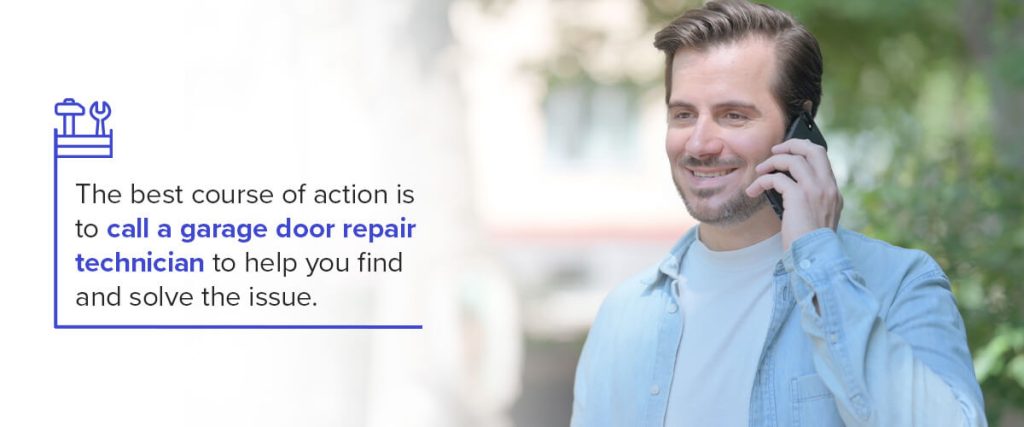
When your garage door doesn’t open and close properly, you need to solve the problem before it gets worse. Various things can cause this problem, including:
- Power source: Your garage door’s power source may not be functioning properly.
- Settings: Critical settings might be limiting your door’s functionality.
- Batteries: Your motor or door opener’s batteries might need replacing.
- Springs: The garage door’s torsion or extension springs might be broken.
- Cables: Your garage door cables might be loose or may have snapped.
- Blockage: Something might be blocking a part of your garage door’s mechanisms.
- Tracks: Your door might have fallen off its tracks, or it may need to be realigned.
- Lock: Your door might be “locked.”
- Sensitivity: Your door’s reverse sensitivity could need adjustment.
You might be able to solve many of these issues yourself if you know what to look for and keep up with regular garage door maintenance. However, major problems need an expert in garage door repair.
4. Your Door Falls off Its Tracks
Garage doors that fall off their tracks can be extremely dangerous. A garage door is heavy, and when it’s off its tracks, the chances of it falling on you or a family member are much higher. This can result in severe injuries and extensive damage to your door and garage.
Your door can dislodge itself from its tracks if the alignment is off, if a roller is damaged or if a cable has broken. If you hit or even nudge an unaligned door with your car, it can cause an overhead door to fall off its tracks with great force. If your door shows any signs of being unaligned or looks like it may fall off its tracks, urgent garage door repair is needed.
5. Your Torsion or Extension Springs Are Damaged
One of the most critical problems a garage door can have is when its torsion or extension springs are broken. Your door uses these springs to open and close. Extension springs are placed on either side of your garage door along its tracks. A torsion spring is centered above your garage door. While the door is closed, both spring types experience high tension. The tension creates the strength required to lift the door open.
If your springs are worn out or broken, your door won’t be able to open anymore. Only a trained garage door technician should handle damaged springs. Because they are so tightly wound, any wrong move can cause them to snap and cause serious injury. Call for a repair service to address any issues with your springs.
6. Your Garage Door Makes a Lot of Noise
A noisy garage door is more than annoying — it can be one of the most noticeable signs that your door needs repairs. Every noise your door makes could signify a different problem. A rumbling or a grating noise might suggest a malfunctioning torsion spring. A popping noise could mean certain sections are intersecting. Depending on the severity of the popping noise this could be a good thing or a bad thing.
When your door starts tracking against the tracks, it will produce an unpleasant grinding sound. If your garage door is making any of these noises or any other unusual sounds, it’s best to call a garage door company to help you find and solve the issue.
Poulson Doors Is Your Go-To Garage Door Repair Service
Poulson Doors is proud to offer the best in garage door installations, maintenance, and repairs. We pride ourselves on providing outstanding work and customer experiences to everyone we work with. At Poulson Doors, we are always looking to the future and staying ahead of the curve by constantly improving our processes and the technology we use. We utilize the latest advancements in safety, warranties, and energy efficiency related to garage doors.
Whether you need help diagnosing your garage door’s problems or a reliable repair service to solve them we are here to help you. We take every job we do seriously and let our strong reputation convince you that we are the right choice for you. Contact us to find out more about what we do and to request a service or an estimate.
